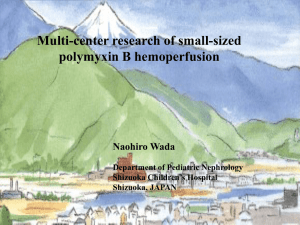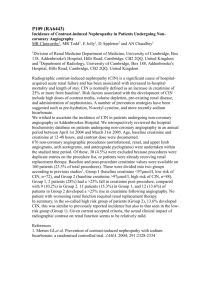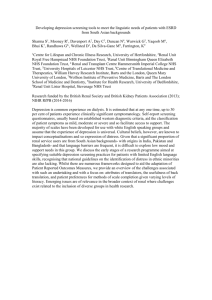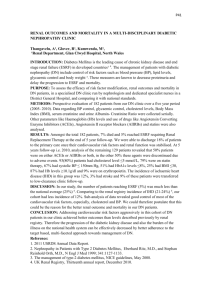Title Page
advertisement
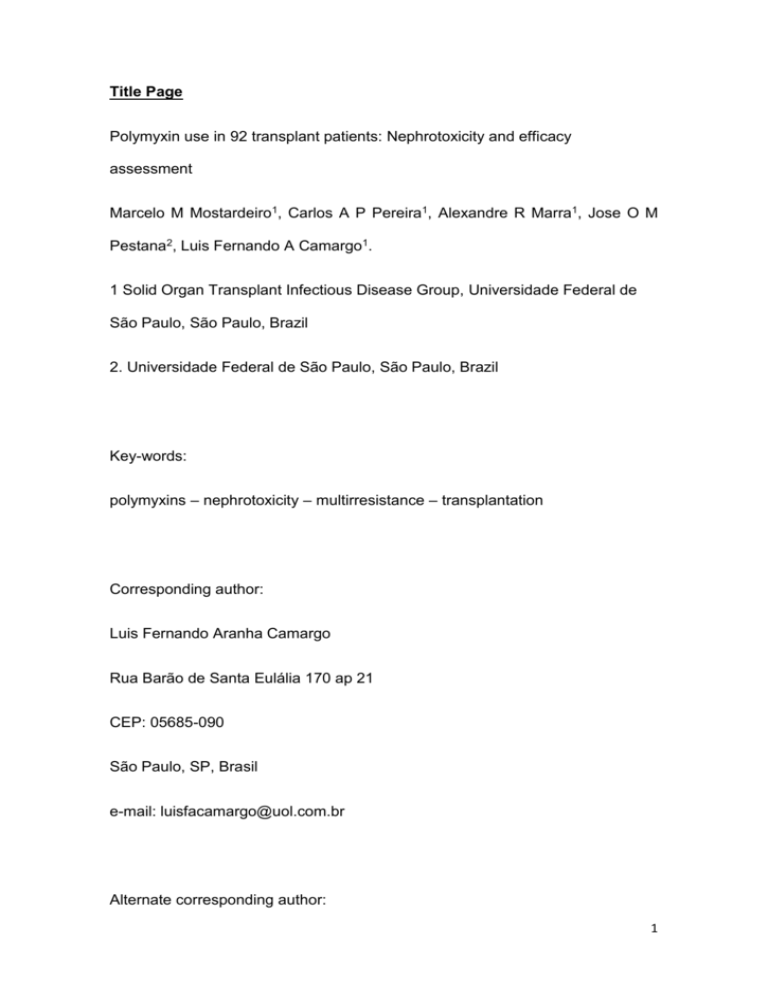
Title Page Polymyxin use in 92 transplant patients: Nephrotoxicity and efficacy assessment Marcelo M Mostardeiro1, Carlos A P Pereira1, Alexandre R Marra1, Jose O M Pestana2, Luis Fernando A Camargo1. 1 Solid Organ Transplant Infectious Disease Group, Universidade Federal de São Paulo, São Paulo, Brazil 2. Universidade Federal de São Paulo, São Paulo, Brazil Key-words: polymyxins – nephrotoxicity – multirresistance – transplantation Corresponding author: Luis Fernando Aranha Camargo Rua Barão de Santa Eulália 170 ap 21 CEP: 05685-090 São Paulo, SP, Brasil e-mail: luisfacamargo@uol.com.br Alternate corresponding author: 1 Marcelo Mileto Mostardeiro E-mail: mm.mostardeiro@gmail.com Rua Cincinato Braga, 130 ap 43 CEP 01333-010 São Paulo, SP, Brasil. Abstract 2 Introduction: Polymyxins are old antimicrobials, discontinued for many years because of nephrotoxicity and neurotoxicity reports and reintroduced recently due to the increasing frequency of multiresistant gram negative infections. Very few data arise from transplanted patients, which is the major aim of this study. Methods: All transplanted patients who used polymyxins were retrospectively assessed for nephrotoxicity and treatment efficacy. Only solid organ transplant patients, submitted to at least 72 h of intravenous polymyxin were included. Results: Overall, 92 transplant patients were included. Nephrotoxicity rates ranged from 32.6% (more restrictive criteria) to 47.8% (any increase in serum creatinine). Multivariate analysis showed a statistically significant association between duration of polymyxin treatment [p 0.037; OR 1.06; IC 95% (1.00 – 1.12)] and significant renal dysfunction . Conclusion: Polymyixin use is associated with very high rates of significant decrease in renal function in transplanted patients. Polymyxins must be used when no other option is available and for as short as possible. Text: 3 Introduction Polymyxins are old antimicrobials, discovered in the 40’s [1], and its clinical use started in the late 60’s [2], acting against gram negative bacteria such as A baumanii, P aeruginosa, K pneumoniae and E coli [1]. Nephrotoxicity and neurotoxicity reports [3-6] and the development of new. broad-active and less toxic anti-gram-negative agents such as cephalosporins and carbapenems led to a brief discontinuation of polymyxin use. However, since the 90’s, an increasing number of reports regarding the emergence of multi-drug resistant gram-negative bacteria, mainly A.baumani and P.aeruginosa, have been published [7]. As a result, polymyxins have re-emerged as an alternative to such multi-resistant organisms. Although recent studies have disclosed lower nephrotoxic rates when compared to earlier reports, toxicity is still a major concern and a reason for not employing this class of drugs [8, 9]. Renal transplant patients are more likely to develop renal toxicity by different mechanisms [10], and renal dysfunction is adversely related to organ and receptor survival [11]. On the other hand, due to the severity of the patients and the frequent use of antimicrobials, gram-negative multiresistance is a major issue in hematopoietic stem cell transplantation and in solid organ transplantation [12-14], raising the ever increasing need for polymyxin employment in this setting. Very few data regarding polymyxin toxicity, specially nephrotoxicity, are available for transplant patients. Our study aimed at analyzing nephrotoxicity rates and clinical and microbiological efficacy of polymyxin in solid organ transplant patients. Material and methods 4 Objectives The objectives of this study are to evaluate nephrotoxicity rates and independent risk factors for nephrotoxicity in solid organ transplant patients receiving polymyxin, as well as describe clinical and laboratorial efficacy of this antimicrobial in this particular population. Patients and methods All medical records from solid organ transplant patients were reviewed. Patients of 18 years or older, who were treated with polymyxin from January 2001 to December 2007 for at least for 72 hours and with no need for dialysis for the first 48h of treatment were included. This study was conducted in 2 university-affiliated-hospitals in São Paulo, Brazil, respectively Hospital São Paulo and Hospital do Rim e Hipertensão. The former is a 700-bed-general hospital and the last is a 100-bed hospital specialized in renal transplantation. The study was approved by the hospital ethics committee. Demographic data We reviewed demographic data from donor, receptor, transplantation procedure, polymyxin use, nephrotoxic drugs used 15 days before and/or during polymyxin use, renal function, and infection. Main definitions 5 Infections were defined according to the clinical judgment of assistant physicians as depicted in medical records. Basal serum urea and creatinine were defined as urea and creatinine values before polymyxin use. Multiresistant bacteria were considered when the pathogen was resistant to carbapenems. Microbiologic cure was defined as clearance in subsequent cultures of a pathogen initially isolated before polymyxin use. Cure or clinical improvement was defined as total or partial resolution of signs and symptoms of infection at the end of polymyxin treatment. We considered death for any cause after 30 days of polymyxin B use, and total hospital mortality rate after polymyxin B use. Potentially concomitant nephrotoxic drugs were: Vancomycin, amphotericin B, ganciclovir, calcineurin inhibitors. Nephrotoxicity was defined according to two criteria: Criteria 1 (significant renal dysfunction) [15]: The creatinine clearance rate was calculated using the equation of Cockcroft and Gault [16]. In patients with normal renal function (serum creatinine level, <1.2 mg/dL), renal failure was defined as a serum creatinine value of >2 mg/dL, as a reduction in the calculated creatinine clearance of 50% relative to the value at antibiotic therapy initiation, or as a decline in renal function that resulted in the need for renal replacement therapy (i.e., intermittent hemodialysis or continuous venovenous hemofiltration). In patients with preexisting renal dysfunction, renal failure was defined as an increase of 50% of the baseline creatinine level, as a reduction in the calculated creatinine clearance of 50% relative to the value at antibiotic therapy initiation, or as a decline in renal function that resulted in the need for renal replacement therapy. 6 Criteria 2 [17]: Renal toxicity was defined as any increase in basal the serum creatinine value. Microbiologic method Antibiotic susceptibilities were determined by disc diffusion and microdilution broth methods according to CLSI (Clinical and Laboratory Standards Institute) standards. Statistical analysis For the evaluation of risk factors for polymyxin nephrotoxicity, we compared groups with and without renal dysfunction at any moment during polymyxin use according only to Criteria 1. Univariate risk factors analysis for categorical variables was performed using Pearson’s Qui-square analysis (X2) or Fisher’s Exact Test (TEF), when supposition for X2 applying wasn’t satisfied. For normal distribution continuous variables was performed t Student test, and for non normal distribution variables we performed Mann-Whitney test. For multivariate analysis multiple non conditional logistic regression model with stepwise variable selection to identify independent risk factors was employed. All significant probabilities presented were bilateral type and values lower than 0.05 were considered statistically significant. Data statistical analysis was performed with SPSS software version 16.0 (Statistical Package for the Social Sciences software, Chicago, IL, USA). Results 7 We retrospectively reviewed medical records from 94 solid organ transplant patients who used polymyxin (polymyxin B and E) according to study including criteria. Two patients were excluded because they needed dialysis within 48h of polymyxin use. Therefore 92 patients were included in the final analysis. The majority of the patients were renal transplants (83.7%), and 70.7% of them received organs from deceased donors. The mean age was 47 ± 14.4 years (20 - 72 years), 57 patients were males (62%), with a medium hospital stay of 75.1 days (3 - 889 days). Other demographic data are presented in Table 1. We considered only the first polymyxin course of treatment (90 polymyxin B and 2 polymyxin E). Polymyxin B was used for a mean of 16.6 days (3 - 46 days). For statistical analysis related to drug dose, time of infusion and length of treatment, we considered only polymyxin B courses. Of all infections, 83.7% were microbiologically confirmed. The major site of infection was the urinary tract (UTI) (41.3%), followed by surgical site infection (SSI) (17.4%) and pneumonia (16.3%). P aeruginosa was the main etiologic agent, present in 76.1% of isolates (Tables 2 and 3). Microbiological cure was observed in 25 patients (100%) (24 urine cultures from receptors and one blood culture from the donor, all of them renal transplants), clinical cure in 71/92 patients (77.2%) and hospital mortality occurred in 21/92 patients (22.8%) (Table 4). Forty-four patients (47.8%) developed nephrotoxicity using any of the 2 criteria employed, 30 patients (32.6%) using criteria 1 (significant nephrotoxicity) and 44 patients (47.8%) using criteria 2. Using Criteria 1 as standard, mean time for renal dysfunction development was 11 days (3 – 24 days). Nephrotoxicity rates were 25%, 30% and 51%, respectively, in days 9, 16, and 29 after polymyxin 8 was started (Figure 1). Fifteen patients (16.3%) required dialysis during polymyxin treatment. Graft loss after polymyxin use was recorded for five patients (5.4%) (Table 4). Using criteria 1 as standard, by multivariate analysis, mean duration of polymyxin treatment [p 0.037; OR 1.06; IC 95% (1.00 – 1.12)] was independently associated with renal failure (Table 5). Discussion Recent studies suggest that polymyxin nephrotoxicity does not occur at a level as high as it was initially described and that its use is safe with variable efficacy [15, 18-23]. Although gram-negative resistance is common in the setting of organ transplantation, little information on polymyxin use is available for this group of patients [17, 24]. Moreover, renal dysfunction is a frequent complication and may affect both patient and graft survival [11]. Efficacy rates of polymyxin are variable and depend on the study population. Michalopoulos et al [25] demonstrated in a series of 43 ICU hospitalized patients a clinical cure rate of 69.8%, and microbiological cure rate of 67.4%. GarnachoMontero et al [15] studying a cohort of 35 patients using colistin or imipenem for A baumanii ventilator associated pneumonia (VAP) treatment reported clinical cure rate of 57% in both groups. In our study we showed higher clinical (77.2%) and microbiological (100%) cure rates. This may be explained by the higher frequency of patients with UTI diagnosis over VAP diagnosis, more frequent in the ICU studies. Moreover, most of our patients were not critically ill, rendering the comparison with a population of exclusively ICU patients not adequate. 9 Nevertheless polymyxin has been shown very effective for UTI treatment, probably reflecting a high urinary concentration [26-28]. Using more restrictive and clinically relevant criteria for nephrotoxicity, rates range from 8 to 45% [29-35] mainly in critical care unit patients in recent studies. No data exclusively for transplanted patients are available in such studies. Using the same criteria as the mentioned studies, we found a high rate of nephrotoxicity (32.6%), although lower when compared to earlier studies (renal impairment ranging from 20.2 to 36%) [5, 8, 9, 36, 37]. A high proportion of patients needed substitutive therapy during polymyxin use. This rate of renal dysfunction is similar to rates described for drugs being substituted for less toxic agents, such as amphotericin B. Bates et al [38] using the same toxicity score employed in our study, reporting data on the treatment of 707 critically patients, reported a renal dysfunction rate of 30% for deoxycolate amphotericin-B. The high nephrotoxicity rate observed in our study overestimates the toxic effect of polymyxin, since kidney transplant patients are prone to renal dysfunction. In fact our patients had initial mean creatinine plasma levels of 2.22 mg / dL and 85.4% had a serum creatinine greater than or equal to 1 mg / dL at the beginning of the study. Multivariate analysis showed that the length of polymyxin use is statistically associated with a worsening of renal function (p <0.037, OR 1.06, 95% CI 1.00 to 1.12). Medical literature contains controversial data on this subject. Falagas et al [19] in a prospective study of 21 patients who used at least 7 days of colistin treatment showed a statistically significant correlation between cumulative antibiotic dose and nephrotoxicity. The same author in another 10 publication [39] retrospectively evaluated 19 courses of colistin for 4 weeks or more and showed that the average rise in serum creatinine compared to baseline value after polymyxin E use was only 0.25 mg / dL. Our study reinforces the hypothesis that length of treatment and cumulative polymyxin use is related to renal dysfunction in solid organ transplantation. The diagnosis of UTI had a marginally protective effect in multivariate analysis. We regard it as a spurious association, since patients with this diagnosis were less severe, based on a lower rate of ICU admission when compared to patients with other infections (7.9% versus 59.3%, p <0.001). Our study has some limitations. The retrospective nature of the study imposes some limitations regarding methodological aspects, mainly for diagnostic and microbiological characterization, and also for renal function monitoring. Since we did not have daily creatinine measurements for all patients, time to reach an end point for neprhrotoxicity may be underestimated. Serum urea and creatinine levels are not ideal markers for renal function assessment, although they are reliable for comparison with literature data. Finally, a lack of a control group and the analysis of a population subjected to multiple interventions impacting renal function may overestimate the real nephrotoxic effect of polymyxin. Although we have disclosed a prohibitive rate of nephrotoxic rate related to polymyxin use in kidney transplant patients, we understand that for multidrug resistant bacteria such as P aeruginosa and A baumanii, polymyxin is sometimes the only viable therapeutic alternative. We suggest for the purpose of reducing nephrotoxicity rates the judicious use only for true infections 11 (restricting for instance the treatment of asymptomatic bacteriuria and tracheal colonization) and for as short as possible. References: 1. Evans ME, Feola DJ, Rapp RP. Polymyxin B sulfate and colistin: old antibiotics for emerging multiresistant gram-negative bacteria. Ann Pharmacother 1999 Sep;33(9):960-7. 2. Lieberson AD, Winter LW, Behnke RH, Martin RR. Extensive pseudomonal pneumonia ultimately responding to polymyxin therapy. Am Rev Respir Dis 1969 Oct;100(4):558-64. 3. Perkins RL. Apnea with Intramuscular Colistin Therapy. JAMA 1964 Nov 2;190:421-4. 4. Landman D, Georgescu C, Martin DA, Quale J. Polymyxins revisited. Clin Microbiol Rev 2008 Jul;21(3):449-65. 5. Fekety FR, Jr., Norman PS, Cluff LE. The treatment of gram-negative bacillary infections with colistin. The toxicity and efficacy of large doses in forty-eight patients. Ann Intern Med 1962 Aug;57:214-29. 6. Gold GN, Richardson AP, Jr. An unusual case of neuromuscular blockade seen with therapeutic blood levels of colistin methanesulfonate (Coly-Mycin). Am J Med 1966 Aug;41(2):316-21. 7. Navon-Venezia S, Ben-Ami R, Carmeli Y. Update on Pseudomonas aeruginosa and Acinetobacter baumannii infections in the healthcare setting. Curr Opin Infect Dis 2005 Aug;18(4):306-13. 8. Koch-Weser J, Sidel VW, Federman EB, Kanarek P, Finer DC, Eaton AE. Adverse effects of sodium colistimethate. Manifestations and specific reaction rates during 317 courses of therapy. Ann Intern Med 1970 Jun;72(6):857-68. 9. Tallgren LG, Liewendahl K, Kuhlbaeck B. The Therapeutic Success and Nephrotoxicity of Colistin in Acute and Chronic Nephropathies with Impaired Renal Function. Acta Med Scand 1965 Jun;177:717-28. 10. Nankivell BJ, Chapman JR. Chronic allograft nephropathy: current concepts and future directions. Transplantation 2006 Mar 15;81(5):643-54. 11. Ojo AO, Held PJ, Port FK, et al. Chronic renal failure after transplantation of a nonrenal organ. N Engl J Med 2003 Sep 4;349(10):931-40. 12. Moreno A, Cervera C, Gavalda J, et al. Bloodstream infections among transplant recipients: results of a nationwide surveillance in Spain. Am J Transplant 2007 Nov;7(11):257986. 13. Linares L, Cervera C, Cofan F, et al. Epidemiology and outcomes of multiple antibioticresistant bacterial infection in renal transplantation. Transplant Proc 2007 Sep;39(7):2222-4. 14. Dobbin C, Maley M, Harkness J, et al. The impact of pan-resistant bacterial pathogens on survival after lung transplantation in cystic fibrosis: results from a single large referral centre. J Hosp Infect 2004 Apr;56(4):277-82. 15. Garnacho-Montero J, Ortiz-Leyba C, Jimenez-Jimenez FJ, et al. Treatment of multidrugresistant Acinetobacter baumannii ventilator-associated pneumonia (VAP) with intravenous colistin: a comparison with imipenem-susceptible VAP. Clin Infect Dis 2003 May 1;36(9):11118. 12 16. Cockcroft DW, Gault MH. Prediction of creatinine clearance from serum creatinine. Nephron 1976;16(1):31-41. 17. Levin AS, Barone AA, Penco J, et al. Intravenous colistin as therapy for nosocomial infections caused by multidrug-resistant Pseudomonas aeruginosa and Acinetobacter baumannii. Clin Infect Dis 1999 May;28(5):1008-11. 18. Markou N, Apostolakos H, Koumoudiou C, et al. Intravenous colistin in the treatment of sepsis from multiresistant Gram-negative bacilli in critically ill patients. Crit Care 2003 Oct;7(5):R78-83. 19. Falagas ME, Fragoulis KN, Kasiakou SK, Sermaidis GJ, Michalopoulos A. Nephrotoxicity of intravenous colistin: a prospective evaluation. Int J Antimicrob Agents 2005 Dec;26(6):504-7. 20. Sobieszczyk ME, Furuya EY, Hay CM, et al. Combination therapy with polymyxin B for the treatment of multidrug-resistant Gram-negative respiratory tract infections. J Antimicrob Chemother 2004 Aug;54(2):566-9. 21. Ouderkirk JP, Nord JA, Turett GS, Kislak JW. Polymyxin B nephrotoxicity and efficacy against nosocomial infections caused by multiresistant gram-negative bacteria. Antimicrob Agents Chemother 2003 Aug;47(8):2659-62. 22. Kallel H, Bahloul M, Hergafi L, et al. Colistin as a salvage therapy for nosocomial infections caused by multidrug-resistant bacteria in the ICU. Int J Antimicrob Agents 2006 Oct;28(4):366-9. 23. Rios FG, Luna CM, Maskin B, et al. Ventilator-associated pneumonia due to colistin susceptible-only microorganisms. Eur Respir J 2007 Aug;30(2):307-13. 24. Linden PK, Kusne S, Coley K, Fontes P, Kramer DJ, Paterson D. Use of parenteral colistin for the treatment of serious infection due to antimicrobial-resistant Pseudomonas aeruginosa. Clin Infect Dis 2003 Dec 1;37(11):e154-60. 25. Michalopoulos AS, Tsiodras S, Rellos K, Mentzelopoulos S, Falagas ME. Colistin treatment in patients with ICU-acquired infections caused by multiresistant Gram-negative bacteria: the renaissance of an old antibiotic. Clin Microbiol Infect 2005 Feb;11(2):115-21. 26. Bergan T, Fuglesang J. Polymyxin antibiotics: chemical and pharmacokinetic properties. Antibiot Chemother 1982;31:119-44. 27. Kunin CM, Bugg A. Binding of polymyxin antibiotics to tissues: the major determinant of distribution and persistence in the body. J Infect Dis 1971 Oct;124(4):394-400. 28. Kuntzman R, Jacobson M, Tsai I, Burns JJ, Burchall J, Koch A. Certain aspects of drug binding to nonplasma proteins as illustrated by studies with cyclizine, chlorcyclizine, and polymyxin B. Ann N Y Acad Sci 1973 Nov 26;226:131-47. 29. Kasiakou SK, Michalopoulos A, Soteriades ES, Samonis G, Sermaides GJ, Falagas ME. Combination therapy with intravenous colistin for management of infections due to multidrugresistant Gram-negative bacteria in patients without cystic fibrosis. Antimicrob Agents Chemother 2005 Aug;49(8):3136-46. 30. Santamaria C, Mykietiuk A, Temporiti E, Stryjewski ME, Herrera F, Bonvehi P. Nephrotoxicity associated with the use of intravenous colistin. Scand J Infect Dis 2009;41(10):767-9. 31. Kim J, Lee KH, Yoo S, Pai H. Clinical characteristics and risk factors of colistin-induced nephrotoxicity. Int J Antimicrob Agents 2009 Nov;34(5):434-8. 32. Mendes CA, Cordeiro JA, Burdmann EA. Prevalence and risk factors for acute kidney injury associated with parenteral polymyxin B use. Ann Pharmacother 2009 Dec;43(12):194855. 33. Falagas ME, Rafailidis PI, Ioannidou E, et al. Colistin therapy for microbiologically documented multidrug-resistant Gram-negative bacterial infections: a retrospective cohort study of 258 patients. Int J Antimicrob Agents Feb;35(2):194-9. 34. Cheng CY, Sheng WH, Wang JT, Chen YC, Chang SC. Safety and efficacy of intravenous colistin (colistin methanesulphonate) for severe multidrug-resistant Gram-negative bacterial infections. Int J Antimicrob Agents Mar;35(3):297-300. 13 35. Hartzell JD, Neff R, Ake J, et al. Nephrotoxicity associated with intravenous colistin (colistimethate sodium) treatment at a tertiary care medical center. Clin Infect Dis 2009 Jun 15;48(12):1724-8. 36. Olesen S, Madsen PO. Intravenous administration of sodium colistimethate in urinary tract infections. Curr Ther Res Clin Exp 1967 Jun;9(6):283-7. 37. Baines RD, Jr., Rifkind D. Intravenous Administration of Sodium Colistimethate. JAMA 1964 Oct 26;190:278-81. 38. Bates DW, Su L, Yu DT, et al. Mortality and costs of acute renal failure associated with amphotericin B therapy. Clin Infect Dis 2001 Mar 1;32(5):686-93. 39. Falagas ME, Rizos M, Bliziotis IA, Rellos K, Kasiakou SK, Michalopoulos A. Toxicity after prolonged (more than four weeks) administration of intravenous colistin. BMC Infect Dis 2005 Jan 10;5(1):1. 14
